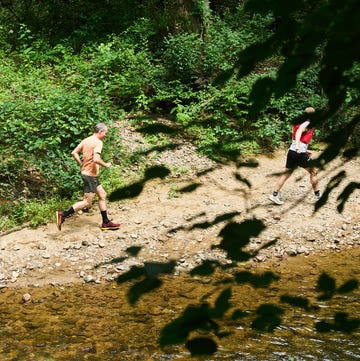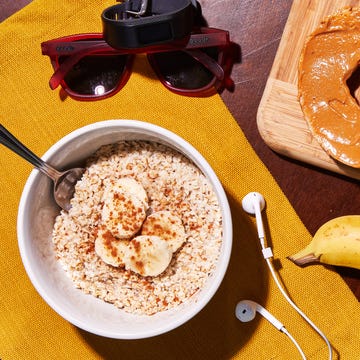The 6 Best Trail Running Socks for Venturing Beyond the Pavement
A good pair will make your run better through managing moisture and heat; the wrong pair will ruin it.

We earn a commission for products purchased through some links in this article. Why Trust Us?
While I wouldn’t place socks above shoes in the Hierarchy of Importance for my next trail run, a good pair of trail running socks is paramount to enjoying time on your feet and not just suffering through the miles. The best trail running socks provide support and cushioning, are made with high-quality, sweat-wicking materials, and don’t rub or create friction (which can lead to hot spots and blisters). Most of my top picks have targeted venting and compression in a foot-mapped design, and all have a high percentage of natural fibers.
Trail running socks are a broad field though, and the best socks for you are whichever ones provide the right amount of cushioning for your preferences, climate, and shoes. Trail socks also come in a range of heights, from sleek no-shows to full-length crew socks. Some runners prefer models with a taller cuff to help keep debris out of their shoes, while others appreciate the freedom of a lower model. Here are my top choices for trail running socks for this year.
For more gear recommendations, check out our picks for the Best Running Socks, Best Running Gaiters, and Best Running Sunglasses.
Best Trail Running Socks
- Best Overall: Lé Bent Targeted Cushion 3/4 Crew Trail Sock
- Best for Hot Runs: Darn Tough Microcrew UL Cushion
- Most Durable: Darn Tough Light Hiker Quarter
- Best for Variable Temperatures: Smartwool Run Cold Weather Targeted Cushion Crew
- Best Blister-Resistance: Balega Ultraglide
- Best Cushion Minus 33 Ankle Trail Running Socks
What to Consider
Look for Zoned Mesh Depending on the Conditions
Most trail running socks include zoned mesh, which facilitates breathability through looser and thinner mesh panels that enhance airflow and ventilation in areas prone to heat and moisture buildup. This targeted design promotes efficient moisture wicking and faster drying, keeping feet cool and dry. This helps regulate foot temperature, reducing the risk of blisters, discomfort, and stink. Runners in hot climates should prioritize socks with this design, like Darn Tough’s Microcrew UL Cushion, which have active zoning that allows breathability and creates structure and support, including less material over the top of the foot with added structure for support, and thicker cushioning around the toes for both padding and abrasion-resistance.

Cuff Height
Socks come in a lot of heights, from no-show to knee-height compression socks. For trail running, I prefer a quarter, mini, or full crew that helps keep debris out of my shoes without feeling too constricting. Within that range, I’ll opt for lower socks for hot weather and taller socks for overgrown trails.
No-Show
The top of this cuff sits below the ankle bone and is barely visible above the collar of a running shoe. These socks aren’t my top pick for dirty or dusty trail runs, but I like them for hot days where I’m not worried about debris. These work best when the socks have a tab, like the Balega Ultraglide, which helps keep them from sliding down into your shoe.
Ankle
The top of the cuff sits right on the ankle bone. This are my preferred height for trails without much that could whack my shins or sneak into my shoes, as these socks provide a little more protection and pair well with lower trail-running gaiters, which sit right around the same height. These also work best when the socks have a tab or stretchy cuff, like Smartwool’s lower-height ankle socks.
Quarter Crew
Sometimes called micro-crew, these socks have cuffs that fully cover the ankle bone. These are my top pick for trail running, as they aren’t too tall to feel hot, but they do provide enough protection for most trails from abrasion and sand or debris.
Crew
These are usually the longest socks you’ll see for trail running, unless you’re opting for a compression-style, which have its place. For crew, the top of the cuff sits at (or slightly below) the middle of the calf, and provides the most protection against dirt and debris along with scratches if you find yourself bushwhacking.
Level of Cushioning
Trail running socks come in a few different levels of cushioning. I’ve found most runners prefer a moderate amount to balance comfort and protection without adding excessive bulk, providing adequate shock absorption to handle rough terrain while maintaining a responsive feel for better performance. I prefer to have a few options on hand depending on my outing.
No Cushion
Non-cushioned socks have no additional padding in the sock fabric. These are good for shorter runs, hot climates, or anything where you won’t be pounding. If you wear highly cushioned shoes, you might also prefer these socks.
Light Cushion
The sock material is thicker underfoot with reinforced fabric, but it still leaves a pronounced feel for the inside of a shoe and can have a more agile vibe than heavier pairs.
Medium Cushion
This is my go-to for trail running. These socks have additional padding underfoot, plus reinforced toes and heels. They take up a bit more space inside of a shoe, but not enough that I have to adjust the lacing.
Max Cushion
The underfoot padding is thick, plush, and immediately obvious in the shoe. Some runners prefer these for long, pounding runs or extra long days on the trail.
Material
Most trail running socks are a blend of merino and synthetic fabrics (including polyester and Lycra). Merino wool is renowned for its moisture-wicking properties, keeping feet dry and reducing the risk of blisters. It also provides excellent temperature regulation in all types of weather. Lycra adds stretch and durability, ensuring a snug fit that prevents slipping and bunching. If the socks have a higher percentage of Lycra and synthetic, they’ll have more compression and structure. A higher percentage of merino means a softer sock with better odor-resistance.
Price
While you can find cheap multipacks of socks (which work for some runners), most trail running socks from reputable brands fall in the same price range, and you can expect to spend between $18-24 per pair. It might seem expensive for socks, but it’s worth the investment. And while we typically include a “best value” selection among our recommendations, it’s hard to find a cheap pair that we trust to keep us cool and blister free.
How We Selected
I have been trail running, hiking, backpacking, and thru-hiking for more than a decade, and testing gear professionally for nearly as long. Testing in person with firsthand experience with updated sock models was important. I used my base knowledge of the category to narrow down my initial picks, then wore different socks for all of my trail runs.

For this update, I went through my testing notes from the past year of runs, hikes, and run-slash-hikes. I considered my new favorites like Le Bent’s 3/4 Crew Trail Sock as well as older standbys that resurfaced into my rotation, like the Balega Ultraglide. I also consulted reviews from Runner’s World editors and testers, since we run in different climates and our feet all have different needs. I also took notes from the original testing from editors in our overall best running socks article as well as my own testing for this year’s top crew socks. I picked a range of socks in weights, heights, and materials, but all fit true to size, wick sweat, dry quickly, and are effective at providing support while reducing blisters.
Full Reviews
Maggie Slepian is a full-time freelance writer in the outdoor industry and has tested gear professionally for almost ten years—she is an avid backpacker, trail runner, bikepacker, and horseback rider and has thru-hiked thousands of miles on the Appalachian, Colorado, and Ouachita trails, along with backcountry travel on terrain including coastal trails, the desert, and high alpine peaks. Maggie has written for New York Magazine, Huffington Post, REI, and Outside. She is a columnist with Backpacker Magazine and is the co-founder of BackpackingRoutes.com. Contact her at MaggieSlepian.com.

Readers Also Read

The Best and Most Comfortable Running Socks Tested

The Best and Most Comfortable Running Socks Tested

The Best Trail Running Shoes of 2025

The Best Trail Running Shoes of 2025












